Navigation
Climate Change Adaptation Investments Can Help Promote Livelihoods of 65% of Africans According to Report
The report, “Investment in Climate Change Adaptation Can Help Promote Livelihoods of 65% of Africans,” provides a snapshot of current and predicted future impacts of climate change on livelihoods, agriculture, and human and ecosystem health in Africa.
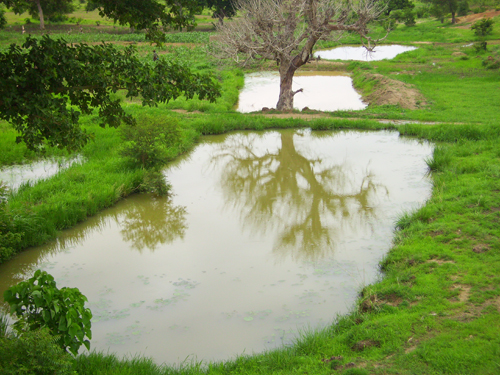 Rehabilitated small dam in Togo: Local communities are increasingly aware of the role of plants and forests in conserving water and soil and of the need to manage landscapes to reduce evaporation and encourage biodiversity renewal. Text and photograph from the Report.
Rehabilitated small dam in Togo: Local communities are increasingly aware of the role of plants and forests in conserving water and soil and of the need to manage landscapes to reduce evaporation and encourage biodiversity renewal. Text and photograph from the Report.
Investment in climate change adaptation can help ensure that the impacts of climate change - including a projected 20–50 per cent decline in water availability – do not reverse decades of development progress in Africa, according to a new report released on 12 August 2014 by the United Nations Environment Programme (UNEP).
Keeping Track of Adaptation Actions in Africa (KTAA) - Targeted Fiscal Stimulus Actions Making a Difference - is the first graphical report that presents practical examples of successful low-cost adaptation solutions from around sub-Saharan Africa in one concise handbook.
The first part of the report provides snapshots of the current and predicted future impacts of climate change on livelihoods, agriculture and human and ecosystem health in Africa, detailing impacts by region, country and even city.
The second half of the report describes how countries through low-cost climate adaptation actions can improve the health and functioning of ecosystems; build community capacity to sustainably manage eco-systems; improve agricultural productivity; and innovatively store water.
For example, an aquatic ecosystems project in one local community in Togo led to an increase in access to water for human use, agriculture and livestock of 488 per cent.
Other examples of successful adaptation projects included in the Report are ones that have provided the impetus for large-scale government investments and policy action, such as:
Ecosystem Management Project
Seychelles
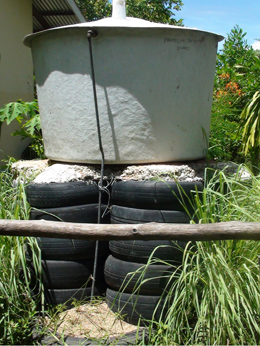 Water cisterns installed in local villages and schools.: Photograph courtesy of UNEP from the Report.Result -
Water cisterns installed in local villages and schools.: Photograph courtesy of UNEP from the Report.Result -
Seychelles introduced national legislation that changed school building codes to enable rainwater catchment systems.
About 400 teachers and the students of seven schools in the Seychelles were educated in ecosystem management principles and schools saved US$250 each on water-related expenses.
Forest Ecosystems Project
Rwanda
Result – In Rwanda 2,500 farmers were trained in land husbandry and 4,850 people were employed and paid via saving and credit cooperatives.
Result - 432 hectares (ha) of graded terraces were established; 73.72 km of waterways, 59.77 km of cut-off drains and a 105 ha drainage system were put in place. 789 ha of forest was planted.
Result - The US$100,000 project served as the impetus for the grander Rwandan Ministry of Agriculture investment of US$25 million.
Uganda
Result – In Uganda an investment of US$13.26 per person per year generated significant gains in ecosystem protection, livelihood improvement and the planting of over 31,000 trees.
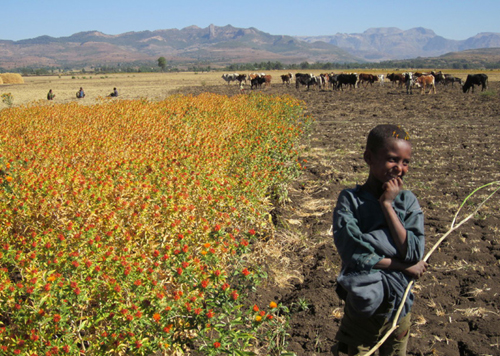 60 % of the Sub-Saharan population depend on the agricultural sector for their livelihoods.: Photograph and text from the Report. Photograph courtesy of UNEP.
60 % of the Sub-Saharan population depend on the agricultural sector for their livelihoods.: Photograph and text from the Report. Photograph courtesy of UNEP.
Agricultural Ecosystems Project
Zambia
Result - The number of participating households with one or more surplus farm products for sale, rose from 25.9 per cent to 69 per cent. While 61 per cent of the households reported that sales of surplus farm products were contributing 50 per cent or more of their income.
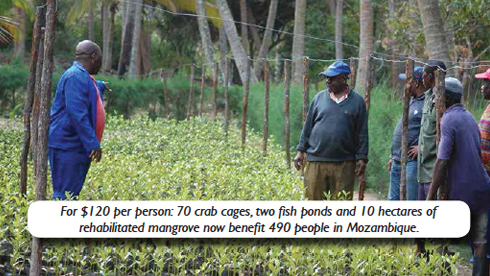 Technicians involved in a mangrove nursery in Mozambique: Photograph courtesy of UNDP-UNEP Poverty-Environment (PEI) Initiative.This project sought to rebuild the resilience of the local ecosystem (and thereby improve the climate change resilience of the local population) through a combination of ecosystem repair and ecosystem services and diversification. The approach and results are discussed in the report, "Keeping Track of Adaptation Actions in Africa (KTAA) - Targeted Fiscal Stimulus Actions Making a Difference .”
Technicians involved in a mangrove nursery in Mozambique: Photograph courtesy of UNDP-UNEP Poverty-Environment (PEI) Initiative.This project sought to rebuild the resilience of the local ecosystem (and thereby improve the climate change resilience of the local population) through a combination of ecosystem repair and ecosystem services and diversification. The approach and results are discussed in the report, "Keeping Track of Adaptation Actions in Africa (KTAA) - Targeted Fiscal Stimulus Actions Making a Difference .”
According to the Report, by 2050 Africa’s population will have doubled. The continent will then be home to 2 billion people, the majority of which will still largely depend on agriculture for their livelihoods.
“With 94 per cent of agriculture dependent on rainfall, the future impacts of climate change including increased droughts, flooding and sea-level rise may reduce crop yields in some parts of Africa by 15–20 per cent,” said UN Under-Secretary-General and UNEP Executive Director Achim Steiner.
“Such a scenario, if unaddressed, could have grave implications for Africa’s most vulnerable States.”
“Using projects implemented in various countries in sub-Saharan Africa, the KTAA report clearly demonstrates how investment in adaptation actions can provide not just low-cost solutions to climate change challenges but can actually stimulate local economies through more efficient use of natural capital, job creation and increased household incomes.”
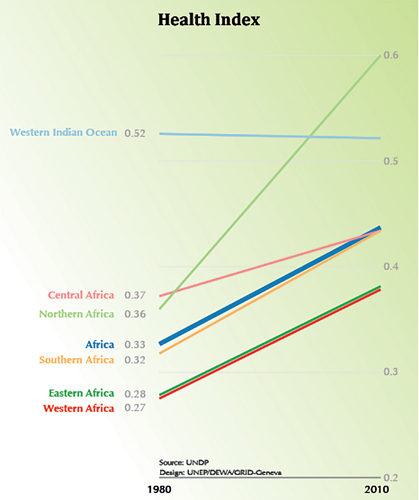 Health Index...: the diseases that pose a threat in many parts of sub-Saharan Africa will continue to include vector- and water-borne diseases such as malaria, Rift Valley fever and cholera. Text and graphic from the Report
Health Index...: the diseases that pose a threat in many parts of sub-Saharan Africa will continue to include vector- and water-borne diseases such as malaria, Rift Valley fever and cholera. Text and graphic from the Report
“By integrating climate change adaptation strategies in national development policies governments can provide transitional pathways to green growth and protect and improve the livelihoods of hundreds of millions of Africans,” he added.
This practical publication responds to the 2013 Africa Adaptation Gap Report which was endorsed by the African Ministerial Conference on the Environment (AMCEN), and which identified the potentially crippling costs of climate change for Africa.
“Incipient threats posed by climate change, particularly in terms of potentially overturning decades of development efforts in Africa, suggest that future development efforts should incorporate greater resilience to climate change impacts,” said the President of AMCEN and Minister of State for the Environment, United Republic of Tanzania, Hon. Dr. Binilith Mahenge.
“The KTAA report is an action guide that showcases ways to do this in various sectors and African countries should use this as the guiding document for investments in adaptation to climate change.”
Notes:
Download Keeping Track of Adaptation Actions in Africa (KTAA) - Targeted Fiscal Stimulus Actions Making a Difference from this link: http://www.unep.org/newscentre/Default.aspx?DocumentID=2797&ArticleID=10951&l=en
The MCEN 2013 Gaborone Declaration is available at: http://www.unep.org/roa/amcen/Amcen_Events/5th_ss/Docs/K1353541%20-%20Gaborone%20Declaration%20by%20the%205th%20Special%20session%20of%20AMCEN%20-%20Final%2022102013%20EN.pdf
About PEI available at www.unpei.org/
“The Poverty-Environment Initiative (PEI) of the United Nations Development Programme (UNDP) and the United Nations Environment Programme (UNEP) is a global programme that supports country-led efforts to mainstream poverty-environment linkages into national development and sub-national development planning, from policymaking to budgeting, implementation and monitoring.
With both financial and technical support, PEI assists government decision-makers and a wide range of other stakeholders to manage the environment in a way that improves livelihoods and leads to sustainable growth. The PEI works with key government partners to raise awareness, influence policy making and strengthen the mainstreaming of poverty-environment into budget processes, sector programmes and sub-national planning. The overall aim is to bring about lasting institutional change and to catalyse key actors to increase investment in pro-poor environmental and natural resource management.” See more at: http://www.unpei.org/#sthash.PedhwGlB.dpuf
This news was provided by UNEP, 12 August 2014, and by published on the Horizon International Solutions Site 14 August 2014.
Search
Latest articles
Agriculture
- World Water Week: Healthy ecosystems essential to human health: from coronavirus to malnutrition Online session Wednesday 24 August 17:00-18:20
- World Water Week: Healthy ecosystems essential to human health: from coronavirus to malnutrition Online session Wednesday 24 August 17:00-18:20
Air Pollution
- "Water and Sanitation-Related Diseases and the Changing Environment: Challenges, Interventions, and Preventive Measures" Volume 2 Is Now Available
- Global Innovation Exchange Co-Created by Horizon International, USAID, Bill and Melinda Gates Foundation and Others
Biodiversity
- It is time for international mobilization against climate change
- World Water Week: Healthy ecosystems essential to human health: from coronavirus to malnutrition Online session Wednesday 24 August 17:00-18:20
Desertification
- World Water Week: Healthy ecosystems essential to human health: from coronavirus to malnutrition Online session Wednesday 24 August 17:00-18:20
- UN Food Systems Summit Receives Over 1,200 Ideas to Help Meet Sustainable Development Goals
Endangered Species
- Mangrove Action Project Collaborates to Restore and Preserve Mangrove Ecosystems
- Coral Research in Palau offers a “Glimmer of Hope”
Energy
- Global Innovation Exchange Co-Created by Horizon International, USAID, Bill and Melinda Gates Foundation and Others
- Wildlife Preservation in Southeast Nova Scotia
Exhibits
- Global Innovation Exchange Co-Created by Horizon International, USAID, Bill and Melinda Gates Foundation and Others
- Coral Reefs
Forests
- NASA Satellites Reveal Major Shifts in Global Freshwater Updated June 2020
- Global Innovation Exchange Co-Created by Horizon International, USAID, Bill and Melinda Gates Foundation and Others
Global Climate Change
- It is time for international mobilization against climate change
- It is time for international mobilization against climate change
Global Health
- World Water Week: Healthy ecosystems essential to human health: from coronavirus to malnutrition Online session Wednesday 24 August 17:00-18:20
- More than 400 schoolgirls, family and teachers rescued from Afghanistan by small coalition
Industry
- "Water and Sanitation-Related Diseases and the Changing Environment: Challenges, Interventions, and Preventive Measures" Volume 2 Is Now Available
- Global Innovation Exchange Co-Created by Horizon International, USAID, Bill and Melinda Gates Foundation and Others
Natural Disaster Relief
- STOP ATTACKS ON HEALTH CARE IN UKRAINE
- Global Innovation Exchange Co-Created by Horizon International, USAID, Bill and Melinda Gates Foundation and Others
News and Special Reports
- World Water Week: Healthy ecosystems essential to human health: from coronavirus to malnutrition Online session Wednesday 24 August 17:00-18:20
- STOP ATTACKS ON HEALTH CARE IN UKRAINE
Oceans, Coral Reefs
- World Water Week: Healthy ecosystems essential to human health: from coronavirus to malnutrition Online session Wednesday 24 August 17:00-18:20
- Mangrove Action Project Collaborates to Restore and Preserve Mangrove Ecosystems
Pollution
- Zakaria Ouedraogo of Burkina Faso Produces Film “Nzoue Fiyen: Water Not Drinkable”
- "Water and Sanitation-Related Diseases and the Changing Environment: Challenges, Interventions, and Preventive Measures" Volume 2 Is Now Available
Population
- "Water and Sanitation-Related Diseases and the Changing Environment: Challenges, Interventions, and Preventive Measures" Volume 2 Is Now Available
- "Water and Sanitation-Related Diseases and the Changing Environment: Challenges, Interventions, and Preventive Measures" Volume 2 Is Now Available
Public Health
- Honouring the visionary behind India’s sanitation revolution
- Honouring the visionary behind India’s sanitation revolution
Rivers
- World Water Week: Healthy ecosystems essential to human health: from coronavirus to malnutrition Online session Wednesday 24 August 17:00-18:20
- Mangrove Action Project Collaborates to Restore and Preserve Mangrove Ecosystems
Sanitation
- Honouring the visionary behind India’s sanitation revolution
- Honouring the visionary behind India’s sanitation revolution
Toxic Chemicals
- "Water and Sanitation-Related Diseases and the Changing Environment: Challenges, Interventions, and Preventive Measures" Volume 2 Is Now Available
- Actions to Prevent Polluted Drinking Water in the United States
Transportation
- "Water and Sanitation-Related Diseases and the Changing Environment: Challenges, Interventions, and Preventive Measures" Volume 2 Is Now Available
- Urbanization Provides Opportunities for Transition to a Green Economy, Says New Report
Waste Management
- Honouring the visionary behind India’s sanitation revolution
- Honouring the visionary behind India’s sanitation revolution
Water
- Honouring the visionary behind India’s sanitation revolution
- Honouring the visionary behind India’s sanitation revolution
Water and Sanitation
- Honouring the visionary behind India’s sanitation revolution
- Honouring the visionary behind India’s sanitation revolution

